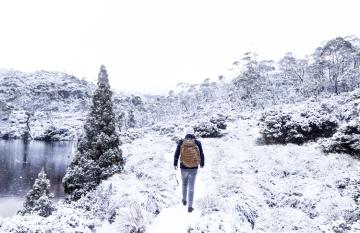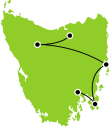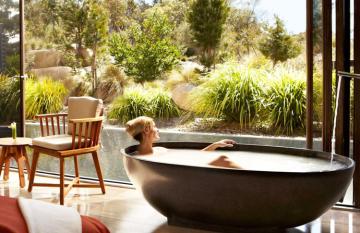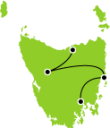
Winter is a wonderful time to visit Cradle Mountain. From walking and wildlife-viewing to fine dining and magical landscapes, discover everything about visiting Cradle Mountain in winter in this guide.

Contents
Cradle Mountain is a beautiful place to visit during winter. Snow covers much of the landscape, and whether simply observing the magical scenery from inside or getting out into the great outdoors through hiking, kayaking, camping and other adventures, Cradle Mountain offers a lot of options for visitors during winter.
Read on for everything you need to know about visiting Cradle Mountain during winter, including what to expect from the weather and the best Cradle Mountain winter activities to do.
What to expect in Cradle Mountain during winter
Winter in Cradle Mountain is between June and September. During this period there is lots of rain, snow, and low temperatures. However, it’s also a time to experience this magical wilderness at arguably its most magical.
You can avoid the larger crowds of other months, and you get to see Cradle Mountain’s stunning landscapes in a beautifully majestic, snow-draped light. Better yet, most of the activities, walking trails, and wildlife-viewing opportunities that attract visitors during the warmer months are available to enjoy all throughout winter at Cradle Mountain.
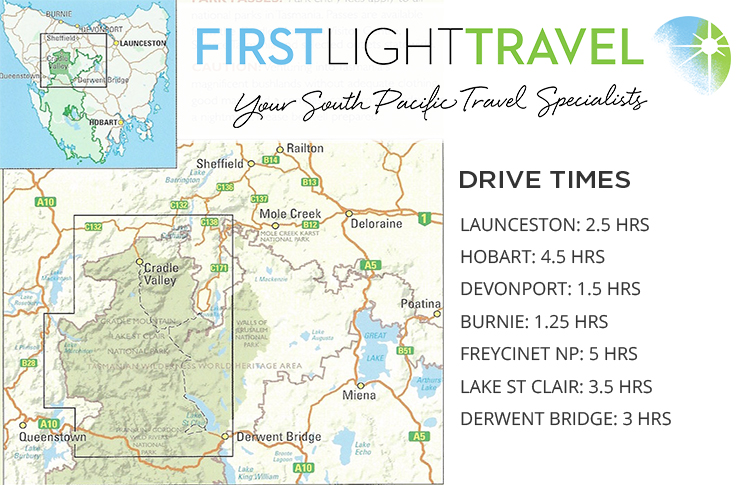
What is the weather like at Cradle Mountain in winter?
Winter rain and snow at Cradle Mountain
Winter is wet in Cradle Mountain, with all of July, August and September typically having higher levels of precipitation, rainfall, wet days, and snowfall than any other month of the year (and June not too far behind them). August is the wettest month of the year, with about 18 days of rain or snow, on average, and well over 200 mm (8 inches) of rain. July and September have similarly high levels of precipitation, although a lot of this falls as snow rather than rain.
In addition, bear in mind that the Cradle Mountain region covers a very diverse landscape. Therefore, different parts of the Cradle Mountain-Lake St. Clair National Park experience different microclimates and localised weather conditions. So while it might be wet and rainy in one part of the park, it could be crisp, clear and dry in another!
Winter temperatures at Cradle Mountain
In terms of temperature, the average daily high in Cradle Mountain is around 8°C (46.4°F) throughout winter overall, with average lows around 2°C (35.6°F). July is typically the coldest month, although nighttime temperatures can dip below freezing during other winter months, too.
The most important thing to keep in mind during winter at Cradle Mountain, especially if you’re going into the higher areas, is that this is an alpine environment. That means the weather conditions can change quickly. Be sure to check the Australian Bureau of Meteorology website for the most accurate, up-to-date forecasts and conditions.
Best Cradle Mountain winter activities
Soaking up the scenery while soaking in a tub
The snow that winter brings to Cradle Mountain adds a touch of magic to the region’s already-stunning landscapes. From the snow-capped summits of Cradle Mountain and Mt. Ossa to the snow-covered boardwalks and fields of Cradle Mountain’s walkways, keeping an eye out for burrowing wombats waddling through the snow, there’s plenty of winter scenery to enjoy. One of the best ways to take in the cool scenery is from the warm comfort of a hot tub or luxury spa, several of which are offered by Cradle Mountain hotels and accommodation providers.
Winter walks at Cradle Mountain
The winter does little to dampen the main appeal for most visitors to Cradle Mountain National Park: world-class hiking trails. With the addition of snowy landscapes and some stunning natural light effects, you might even get a better Instagram shot or lasting memory than in other months. The Dove Lake Circuit is a particularly popular winter trail, since its location at the base of Cradle Mountain makes it a bit more immune to snow and colder temperatures than the higher altitudes, while it still covers a decent distance. For those only wanting to go outside for shorter winter bursts, the Enchanted Forest Walk and Pencil Pine Falls trails can each be done within half an hour from the village, or the famed King Billy Pine Track takes only a little longer.
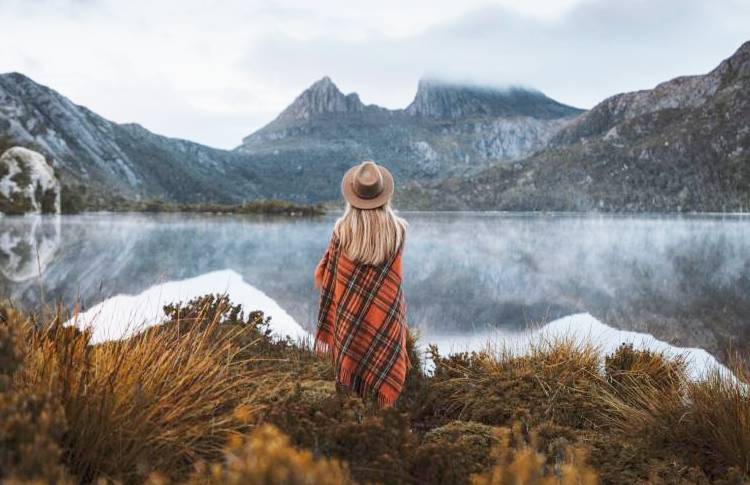
Warming meals, wine and whisky
With Cradle Mountain restaurants sourcing a lot of superb local Tasmanian produce from nearby, winter can be a great time to settle in and savour some delicious food and drink. Curl up by the fireside with a heartwarming Cradle Coast Pinot Noir or a local Tasmanian whisky, or dine out on some exquisite local lamb, truffles, or artisan cheeses. If you want to trace it straight to the source, winter is also a great time to enjoy the fabulous Cradle to Coast Tasting Trail. If you’re feeling extra festive and/or in need of some holiday cheer, the Cradle Mountain Hotel even puts on a fabulous mid-winter Christmas feast every July!
Take a majestic winter cruise on Lake St. Clair
Walking isn’t the only way to get yourself to a good vantage point for enjoying Cradle Mountain’s stunning winter landscapes. Instead, you can take advantage of fabulous ferry and cruise services across the ‘sleeping waters’ of Australia’s deepest lake, Lake St. Clair (Leeawuleena), situated in the southern part of the Cradle Mountain-Lake St. Clair National Park.
Services generally run between Echo Point, Cynthia Bay and Narcissus. Getting out onto the lake offers a prime, undisturbed perspective in many directions: back towards the snowy dolerite ridges of Mt. Olympus and the glacier-carved peaks of Mt. Byron and the Traveller Range; the Narcissus wetlands with their stunning backdrop of the Gould Plateau (a favoured habitat of Cradle Mountain’s elusive platypus); or the snowy-tree-lined moraines of the Franklin Beaches and entangling headwaters of the Derwent Valley.
Cuddle up with Tasmanian wildlife
Cradle Mountain is a haven for lots of local wildlife, and don’t worry – they’re used to the colder, wetter conditions of winter. In fact, winter can be the best time to spot some of Tasmania’s most famous and rarest wildlife, given that fewer humans around means some of Cradle Mountain’s shyest creatures are more likely to venture out.
None is more elusive than the platypus, which can occasionally be spotted near riverbanks and waterways (particularly in the southern areas of the national park, around Lake St. Clair). Closer to the Cradle Mountain visitor centre and Cradle Mountain village, you can frequently see snow-dusted wombats burrowing and wobbling around, as well as curious echidnas foraging for worms, their thick coat and protruding spikes showing they aren’t to be deterred by the weather. The best way to see the world-renowned Tasmanian devil up close is at the wonderful Devils @ Cradle conservation centre, open year-round.
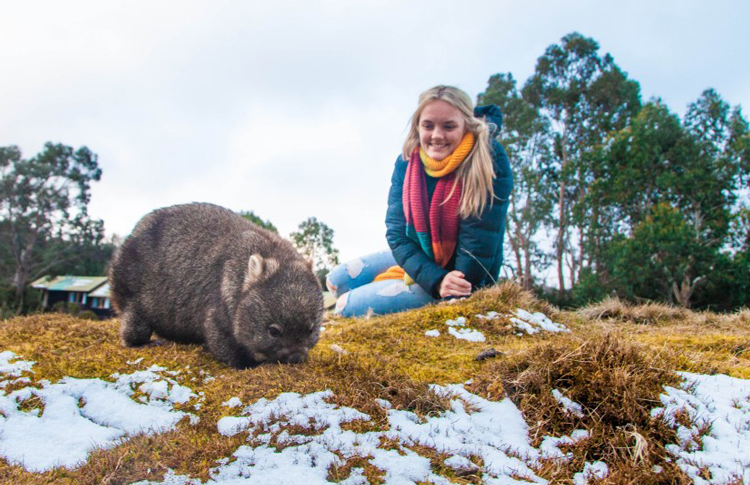
Extra tips for visiting Cradle Mountain during winter
Check the forecasts
As mentioned above, weather can change quickly in the mountains. Particularly during winter, it’s wise to be up to date with the latest weather forecasts and conditions from official sources (like the Australian government’s Cradle Valley forecast).
Driving in Cradle Mountain in winter
Similarly, the snow in and around Cradle Mountain can occasionally lead to roads being blocked and/or closed on the way in. This won’t stop your visit – it just might take some rerouting or manoeuvring. Again, check the official Tasmania Police Community Alerts page for any official road closures. You don’t need to worry about driving inside the national park, as the free (with a Parks Pass) shuttle bus service will get you anywhere you need to go.
If you like the sound of seeing Cradle Mountain in winter and want to start planning your trip now, check out First Light Travel’s range of Tasmania self-drive tours and other detailed information about visiting Tasmania on their website. If you want to design your own Tasmanian winter tour itinerary, simply contact FLT directly and they can help you put it together, free of charge.
Recent Posts
Blog Categories
Blog archives
- March 2025 (1)
- November 2024 (1)
- October 2024 (1)
- September 2024 (8)
- June 2024 (4)
- May 2024 (2)
- April 2024 (2)
- March 2024 (13)
- February 2024 (3)
- January 2024 (5)
- December 2023 (6)
- November 2023 (4)
- October 2023 (11)
- September 2023 (2)
- August 2023 (6)
- July 2023 (2)
- June 2023 (17)
- May 2023 (3)
- April 2023 (5)
- March 2023 (8)
- February 2023 (9)
- January 2023 (12)
- December 2022 (9)
- November 2022 (12)
- October 2022 (12)
- September 2022 (12)
- August 2022 (6)
- July 2022 (9)
- June 2022 (7)
- May 2022 (3)
- April 2022 (4)
- March 2022 (6)
- February 2022 (1)
- January 2022 (4)
- December 2021 (2)
- November 2021 (3)
- October 2021 (1)
- September 2021 (4)
- August 2021 (10)
- July 2021 (13)
- June 2021 (6)
- April 2021 (2)
- March 2021 (2)
- February 2021 (1)
- January 2021 (1)
- December 2020 (2)
- November 2020 (3)
- October 2020 (2)
- September 2020 (1)
- August 2020 (1)
- July 2020 (1)
- June 2020 (1)
- May 2020 (1)
- March 2020 (1)
- February 2020 (2)
- January 2020 (4)
- December 2019 (2)
- November 2019 (1)
- October 2019 (1)
- September 2019 (5)
- August 2019 (1)
- July 2019 (5)
- June 2019 (1)
- May 2019 (1)
- April 2019 (1)
- March 2019 (1)
- February 2019 (1)
- January 2019 (1)
- December 2018 (1)
- October 2018 (1)
- May 2018 (1)
- February 2018 (1)
- December 2017 (1)
- October 2017 (1)
- June 2017 (1)
- May 2017 (1)
- February 2017 (1)
- January 2017 (1)
- September 2016 (1)
- August 2016 (2)
- July 2016 (1)
- June 2016 (1)
- May 2016 (1)
- April 2016 (1)
- December 2015 (1)




